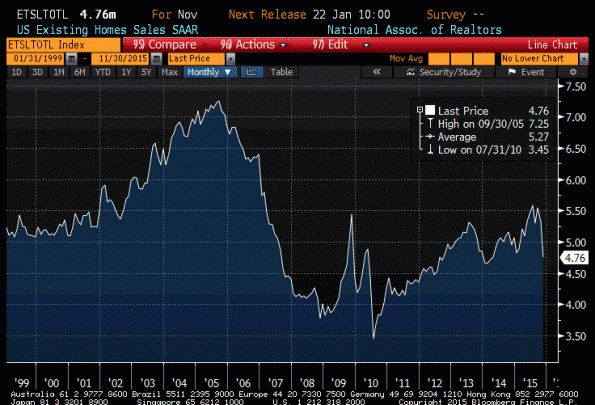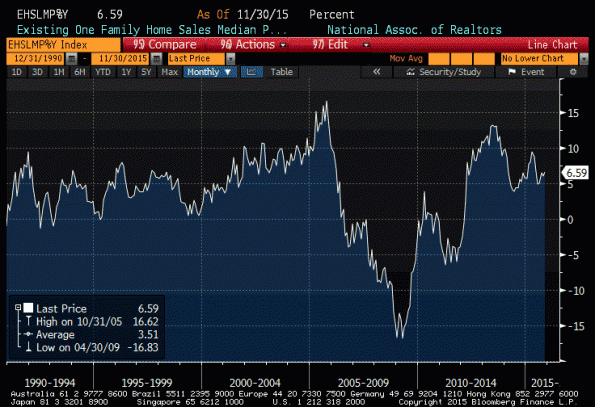It is not usually a very productive endeavor to write an article on December 22. In the past, I have made it more or less a rule not to post anything after about the middle of the month, unless it was a greatest-hits repost series or something. However, today’s Existing Home Sales number was striking enough that it is worth at least a brief comment.
November Existing Home Sales was reported at 4.76mm units (seasonally-adjusted annualized rate), which was considerably below expectations for a nearly-unchanged 5.35mm. The chart (Source: Bloomberg) below makes graphically clear the magnitude of this disappointment.
Recently, sales of existing homes had been back to something like normal, around 5.5mm units at an annualized rate. The big selloff will cause consternation in some quarters. It wasn’t the weather: November’s weather was, if anything, warmer than usual and so one wouldn’t have thought foot traffic and closings would have been slower. And it wasn’t payback, like in 2010 when the collapse followed the tax-incentive-expiration-induced spike of 2009. We can’t really even shrug it off as “December economic data;” I am always skeptical of economic figures from December and January because it’s just a mess to seasonally adjust most of them – especially those related to employment and income. But this was a November figure.
It was just a really bad number.
The potential significance is this: so far, analysts pointing to weakness in economic data have had to be careful about drawing too-strong conclusions because a lot of the weakness was confined to the oil and gas extraction industries, and spots of weakness in traditional manufacturing where a higher dollar hurt. Housing, however, is wholly domestic. It doesn’t depend on oil and gas extraction, and the strength of the dollar is irrelevant.
Housing data are also notoriously volatile, although that complaint is less true of Existing Home Sales than New Home Sales (which is a much smaller figure, and depends much more on what inventory of homes is being offered). I would simply ignore this figure if it was New Home Sales. It’s harder to shrug off Existing.
I don’t believe a collapse is coming, though. Despite the fact that I have just made several observations that tend to increase the significance of this number, keep in mind that unlike in 2005-2007, there is no apparent bubble in the inventory of existing homes (see chart, source Bloomberg – note it is not seasonally adjusted so there is a distinct annual pattern).
The National Association of Realtors blamed the drop on a new regulation affecting closing documents, which is leading to a longer time-to-close for sales. If that is true – keep in mind that the NAR produces the existing home sales figure, but also keep in mind that they have an incentive to downplay declines – then we should see Existing Home Sales rebound in the months ahead. But even if we do not, the fact that there is no bubble in inventory means that we should not necessarily expect the rate of increase of existing home sales prices (which has been running around 6.5%, as the chart below shows) to decelerate any time soon. And that, of course, helps to drive a big piece of the CPI.
All in all, this is a disturbing number and one that bears watching. My intuition is that this is not a sign of broadening weakness in the US economy. While I expect such a broadening, I don’t think we have seen it yet.



